Abstract
The lateral oscillations of vehicle trajectories are a significant cause of collisions. There is a dearth of research, however, on the oscillatory behaviors of vehicles driving on straight sections of freeways. This study aimed to investigate the effects of vehicle type, lane position, and speed on oscillation behavior and to propose quantitative indicators to explain lateral oscillation characteristics. Based on these characteristics, a more appropriate lane width can be determined. First, the k-means algorithm was performed to cluster the vehicles into three categories: passenger cars, medium-large cars, and extra-large trucks. Then, statistical methods such as analysis of variance (ANOVA) and regression analysis were employed to elaborate on the speed distribution, lateral amplitude (LA), and distance traveled within the oscillation cycle (DTOC) for various vehicle types. The results show that different types of vehicles have different lateral oscillation tendencies. The LA and DTOC for passenger cars are generally more extensive than for medium-large cars and extra-large trucks, and their oscillation patterns are the most complicated. The vehicle trajectory oscillation pattern varies significantly for different lane positions and speeds, but speed is the dominant influencing factor. The naturalistic driving dataset from German freeways served as the foundation for this study. These results can assist road engineers in better understanding the behavioral characteristics of vehicle trajectory oscillations and designing safer freeways.
1. Introduction
Lane width is a crucial design indicator of road geometry and an essential factor affecting the safety of vehicle operation. The lane width configuration of the mainline freeway has a direct impact on how risky it is for vehicles to operate along the entire road stretch. If the lane width is overly broad, the lateral clearance of the vehicles is too high, which will quickly lead to a decrease in driver lane sensitivity or even distracted driving. The likelihood of multi-vehicle parallelism and speeding behavior will grow as a result. If the lane is too narrow, the free-flow speed of the car will be significantly reduced. It will also increase the possibility of collisions between vehicles and on the side of the road. Therefore, to satisfy the needs of traffic safety and the efficient operation of vehicles, the lane width must be specified.
With an increase in car ownership and commutes, there is a growing demand for more capacity on the earlier-built freeways. In order to lessen traffic congestion, it is necessary to extend the width of the road cross-section. Meanwhile, traffic control is assuming an increasingly important role [1]. Since passenger cars make up the majority of traffic flow, most multi-lane freeways include inner lanes dedicated to passenger cars to separate passengers from freight traffic. The construction of an exclusive freeway with a higher design speed and focused on serving passenger cars is another option. Whichever approach is adopted, it is crucial to comprehend how lane width changes may affect drivers and passengers, especially in terms of safety. Furthermore, the parameters of lane width for different speeds, lane positions, and vehicle types are not apparent.
However, most cars still have plenty of room to maneuver with the present width of freeway lanes. The driver has more options to control the car’s lateral position on the road so that the vehicle’s trajectory appears to oscillate laterally within the lane. The study of vehicles’ trajectories while maintaining a lane can thus help with lane design. On the other hand, the characteristics of vehicles’ trajectories are also a critical element in studying traffic safety causation and revealing the accident mechanism.
Accordingly, reasonable lane width optimization is required to increase road capacity without compromising vehicle operating speed and better regulate the stability and safety of cars to decrease the frequency of traffic accidents. The primary goal of this research is to clarify the lateral oscillation characteristics of vehicle trajectories on straight sections of freeways and investigate the factors that influence them. The findings allow for the quantification of the trajectory oscillation behaviors of vehicles on the freeway and the construction of proper lanes based on requirements for traffic safety and driving behaviors.
2. Literature Review
Multiple studies have demonstrated that lane width significantly affects road capacity, operating safety of vehicles, and driving behaviors [2,3]. Additionally, it is influenced by the lateral oscillation of trajectories. This section will review and synthesize existing related studies, including the design and determination methods of lane width, the motion characteristics of vehicle trajectories, and lane keeping.
2.1. Design and Determination of Lane Width
The width of the vehicle, the lateral safety clearance, and the lateral oscillation of the trajectory make up the three primary components of lane width. Each country’s road design specifications or guidelines provide the recommended lane widths for various road conditions. For example, the standard highway design reference document in the United States suggested that highways have a lane width of 12 ft (3.66 m) and a lane width of 9 ft (2.74 m) may be used on sections with lower traffic volumes and design speeds [4]. According to Chinese highway technical requirements, the recommended lane width for highways is 3.75 m, although it can be reduced to 3.50 m when passenger cars are the predominant traffic [5]. The German Road and Transportation Research Association stated that the width of the right-hand lane, mainly used by heavy vehicles, should be 3.75 m, while the left lane can be set at 3.5 m [6]. The Transportation Association of Canada stipulated that the lane width of highways was 3.5 to 3.7 m [7], while the UK Highways Agency considered 3.65 m or 3.7 m to be the usual lane width [8]. In addition, the Transportation Research Board (TRB) determined that the standard width for freeway lanes is 12 ft (3.66 m), and it came to the conclusion that there is no direct impact on the free-flow speed when the lane width exceeds 12 ft [9].
It was advised that the lane width be set lower than the normal setting in the code because many academics believed that the current lanes are excessively wide. Kondyli et al. [10] concluded that the Highway Capacity Manual (HCM) was obsolete for lane width adjustment and therefore developed a model to forecast how narrow lanes would affect traffic flow efficiency. Dixon et al. [11] studied the effect of lane width reduction on the overall safety performance of highways. The breadth of the left shoulder had a bigger impact on crash rates than the lane width, and it was discovered that the level of safety would be hard to increase when the lane width exceeded 12 ft. Fitzpatrick et al. [12] explored the effect of lane width reduction on freeway operational efficiency. They concluded that operating speeds were less changed between 12-foot and 11-foot lanes under identical conditions. In China, numerous cities are starting to retrofit and test narrow lanes. For instance, Shanghai compressed the lane width of an urban expressway from 3.25 m to 2.7 m, thereby creating an additional lane. According to the results [13], lane reduction improved capacity and conserved road space.
Meanwhile, some previous studies have carried out pertinent investigations into the acceptable lane width. One way involved using the Bolyankov model from the Soviet era to control the lateral safety spacing between vehicles and between vehicles and curb strips in order to determine the proper lane width. Wang et al. [14] modified the Bolyankov model by fitting the measured data and using the 85th percentile velocity as the design speed. Chang et al. [15] statistically analyzed the relationship between lane width and lateral safety distance, saturation flow, and other factors at urban road signal intersections using questionnaires and Delphi methods.
In several studies, the impact of driving behaviors and traffic flow characteristics has also been taken into account while designing roadway alignments, including research on lane widths for safety purposes. Wu et al. [16] quantified the effect of different lane widths on the crash frequency of vehicles in various types of accidents on urban freeways based on vehicle crashes and traffic flow data. The results showed that the standard-size lane (3.45 m) had the lowest crash risk. However, the comparison of the combined impact of various widths on the vehicle operating level is typically required for the refinement study of lane width. While regulating the variable in practice is more challenging, some researchers have also found a way to circumvent this problem by employing simulation or driving simulators. Using a driving simulator, Liu et al. [17] examined how lane width, position, and shoulder width affected driving behavior. Contrary to Dixon and Fitzpatrick’s study for safety levels and operational efficiency [11,12], they discovered that the development of lane width on driving behavior was more robust than shoulder width. Mecheri et al. [18] investigated the effects of different lane and shoulder widths on the lateral position of vehicles and speed with a driving simulator. They concluded that a two-lane rural road with a design speed of 90 km/h would be adequate for the (3 m, 0.5 m) lane-shoulder width combination. In addition, lane utilization and the driver’s lane-choice behavior are other factors that affect lane setting. Shirke et al. [19] showed that speed and class of vehicle significantly affected drivers’ lane choice behavior. Yousif et al. [20] concluded that there was no considerable distinction between narrow-width and regular-width lanes on drivers’ lane choice behavior.
It can be shown that numerous studies continuously demonstrated that the lane width regulations in place were overly conservative. Vehicle speed reduction and lateral position change were only slightly affected by the lane narrowing within acceptable bounds.
2.2. Vehicle Trajectory Oscillation and Lane Keeping
Lane keeping is the tendency of the driver to drive steadily in a lane by remaining in the center as closely as possible. Another way to put it is the lateral placement of vehicles across lanes on roads [21]. Nevertheless, the lateral oscillation of vehicles during driving is a fundamental cause of many traffic accidents, such as lateral collisions and vehicle rollover. Road alignment affects trajectory oscillation, and the consistency of vehicle trajectory and road alignment forms the cornerstone of road geometry design. The existing lane was created with the presumption that the vehicle’s centerline and the lane’s centerline coincide, and that the space between the two represents the vehicle’s lateral offset [22]. Individual differences, like driving habits and experience, prevent human-driven vehicles from consistently keeping in the center of the lane, which causes the vehicles to drift toward the edge of the road. The drivers will adjust the vehicles back to the centerline if the lateral amplitude exceeds a particular threshold they perceive. It will also lead to safety issues because the cars would continuously oscillate and swing inside the lane. This is in contrast to connected autonomous vehicles.
Some researchers try to investigate the properties of vehicle trajectory oscillation to help comprehend lane departure. Yu et al. [23] demonstrated the consistency between vehicle trajectory and speed. They found a positive correlation between trajectory offset and traveling speed in curved sections. From this, it can be inferred that the speed shift results in a vehicle trajectory offset. Chen et al. [24] analyzed the effect of combined alignment on lane deviation and concluded that horizontal curvature and slope are the primary determining factors. Ghasemzadeh et al. [25,26] looked into how the weather affected lane-keeping ability and driving behavior. They discovered that inclement weather increased both the frequency and severity of lane departures. Hu et al. [27] attributed the lateral offset of trajectory during a non-active lane change to two main reasons: driving inattention and distraction.
In order to examine the lateral location of trajectories, another way relies on video processing and vehicle-detecting technologies. Raju et al. [28] found that vehicles tend to deviate toward the centerline during low traffic volumes and toward the roadside during high traffic volumes by analyzing video data from a multi-lane highway. Kanagaraj et al. [29] used specialized software to extract vehicle trajectory data from video sequences and found discrepancies in the lateral offsets of different vehicle types within the road cross-section.
Table 1 shows the lane-width specifications for freeways in different countries and a comparison of the present studies. In summary, many achievements have been made in studying the driving trajectory. The scenarios for these studies are usually tough roads, such as mountain roads, curved sections, and intersections. Vehicle trajectory is not only affected by the external environment (e.g., road alignment, weather conditions, and traffic flow), but also by the driver’s personal attributes (e.g., speed control, lane choice, and other driving habits). It is common knowledge that the mainline of the freeway is dominated by straight sections where about 70% of traffic accidents occur. The safety level of the freeway will be directly impacted by how well the automobiles operate on straight sections. Unfortunately, a few studies have been conducted to explore the characteristics of trajectories on straight sections of freeways, and the lateral oscillations of different vehicles have not been entirely carried out. Moreover, the lane width depends heavily on the lateral oscillation of the vehicle, but the relationship between them is still unidentified.

Table 1.
Comparison of specifications for lane width and review of the present studies.
3. Materials and Methods
3.1. Data Source
With the advancement of deep learning, vehicle detection technology based on motion information and feature extraction is widely used in the research of driving behavior, vehicle operation, and road safety design. Since unmanned aerial vehicles (UAV) can observe and record vehicle operations from a bird’s eye perspective and do not interfere with natural driving behavior. As a result, an increasing number of academics are using UAVs for traffic flow collection and trajectory data development.
This study used the highD dataset to explore the trajectory oscillations of vehicles. The highD dataset used a computer vision algorithm (U-Net) for semantic segmentation of the vehicle and road background to record drone video of vehicles traveling on German highways near Cologne [30]. It contained six different routes and consisted of two main parts: one for each vehicle’s driving trajectory and the other for introductory details on the test roads. Each of the six locations is a straight section and covers a distance of 420 m. The duration of the video recording is 16.5 h, with a total of 110,000 vehicles.
3.2. Test Road Segments
The essential information and vehicle data collection of the six road sections in the recordings are compiled in Table 2 based on the details of the highD dataset. The table displays four locations where there is no posted speed limit, and the other two locations with a speed limit of 120 km/h and 130 km/h, respectively. The study sites can be divided into four and six lanes in both directions, depending on the number of lanes and the configuration of the road cross-section. The six-lane divided freeway is the primary experimental section with 88.1% of the sampled vehicles and 2/3 of the tested scenes. An aerial view and cross-section of the two types of roads are shown in Figure 1 and Figure 2.

Table 2.
Information and data collection for each location.
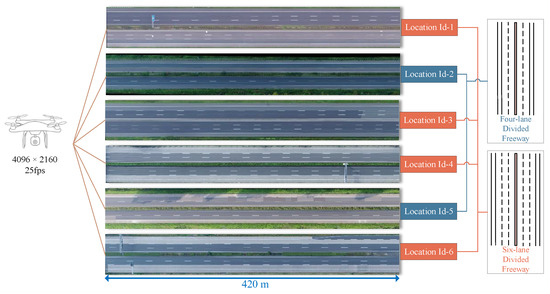
Figure 1.
An aerial view of the straight sections on the test freeways.
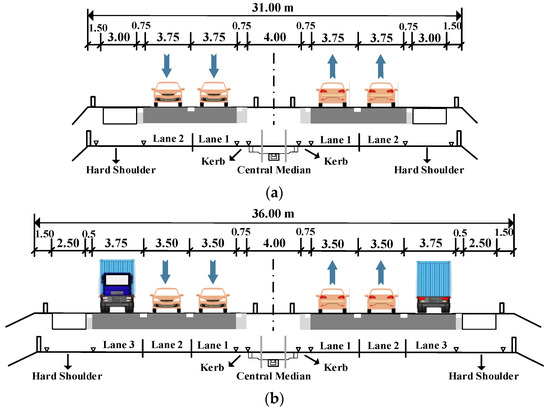
Figure 2.
(a) Cross-section of the four-lane divided freeway; (b) Cross-section of the six-lane divided freeway.
Each lane on the four-lane divided freeway is 3.75 m wide, making it possible for all types of vehicles to go on it. The six-lane divided freeway’s middle and inside lanes are both 3.5 m wide, whereas only the outside lane has a width of 3.75 m. According to the preliminary statistics, truckers occupied the outside lane at a rate of 80.1%, while passenger cars did so at a rate of 11.5%. The fact that the outside lanes are wider than the middle and inside lanes demonstrates how rigidly German drivers adhere to the separation of passengers and freight.
3.3. Trajectory Oscillation
The characteristic parameters of each car’s lateral motion were determined to examine the trajectory oscillation features at the micro level. Specifically, the lateral amplitude (LA), the distance traveled in the oscillation cycle (DTOC), and the mean speed were included. An example of the lateral oscillation of the trajectory is shown in Figure 3. The causes of the lateral offset of the car can be divided into two types: compulsory (caused by lane changing, Situation 1 in Figure 3) and non-compulsory (caused by lane keeping, Situation 2 in Figure 3). However, only the Model 2 conditions were taken into consideration in this study because the characteristics of trajectory oscillation while maintaining the lane are more effective in analyzing the reasonable lane width and the applicable range.

Figure 3.
Schematic of lateral oscillation of vehicle trajectory.
The lateral amplitude reflects the degree of vehicle excursion while driving inside the lane, expressed in the driving trajectory as slight fluctuations up and down within a specific range. The value of the LA is the difference between the vehicle’s maximum and minimum lateral position within the lane, as shown in Equation (1).
where and are the vehicle's maximum and minimum lateral positions in meters.
The DTOC is the distance traveled when the vehicle finishes one complete up-and-down oscillation process (i.e., one oscillation cycle). The mean speed is the ratio of the DTOC to the oscillation time. The two parameters are calculated as follows:
where and are the longitudinal positions corresponding to when the trajectory reaches the maximum and minimum values of the lateral position, is the mean speed, and are the corresponding video frames, and is the frame rate, take 25 fps.
3.4. Data Reduction and Processing
Preliminary screening and post-processing of valid data were necessary due to the highD dataset’s colossal bulk and the fact that some of the data did not fit the scope of this study. For this purpose, we established the following principles to simplify data.
(1) Remove any vehicle data that remains in the frame at the start and end of the video. These vehicles have incomplete traveling trajectories because of the lack of a comprehensive record of the car.
(2) Exclude trajectory data that have a travel distance of less than 390 m. This portion of the data is removed since the road that the recordings cover is 400–420 m long, and some vehicles have large bodies and discontinuous trajectories.
(3) Only retain the trajectory data with no lane changes (i.e., the number of lane changes is zero). Meanwhile, a few vehicles continued to the kerb or the hard shoulder, which is inconsistent with the optimum situation for this study as well.
(4) Some vehicles were about to complete a lane change as they entered the screen or were about to leave the screen when they were ready to make a lane change. Although the number of lane changes for these vehicles remained zero, the influence of their trajectory was entirely due to the lane change behavior. It can be eliminated by comparing the value of the LA with the difference between the lane width and the vehicle width. The vehicle is regarded as making preparations for a lane change when the LA is higher than the difference.
(5) Finally, there is a partial vehicle whose lateral position maximum (or minimum) was close to the start frame (or end frame) of its recording. This meant that the collected trajectory did not comprise a completed oscillation cycle because the vehicles failed to reach a peak or valley in the lateral position in the records.
After the preliminary screening process, 35,223 vehicles’ driving trajectory data were retained. Then, the type of vehicle needed to be clarified. However, the highD dataset had problems classifying car types (Figure 4a), and many cars and trucks had overlapping dimensions. It could make the final results ambiguous and cause the oscillation characteristics of all vehicles to converge. In actuality, the trajectories of different vehicles range greatly, and confusing the vehicle classifications would prevent a more effective analysis for each type of vehicle. As a result, this study used clustering methods to reclassify vehicle types by taking vehicle length and width as analysis variables. After comparing various clustering methods, the k-means algorithm was ultimately selected to reduce the errors in the classification. The k-means algorithm is more convenient and efficient for processing large samples and two-dimensional variables and can effectively classify vehicle types based on vehicle dimensions. According to the preliminary classification results, the classification of vehicles by the k-means algorithm is also better in line with international standards.

Figure 4.
(a) Vehicles classification of the original dataset; (b) K-means clustering results.
The iterative process of the k-means algorithm was to continuously minimize the Euclidean distance (Equation (4)) from each sample to the cluster center and update the cluster center’s position according to the newly divided clusters. Then, each data point was assigned to the nearest cluster. The optimal goal of this algorithm is to minimize the sum of squared errors (SSE) within a cluster, as shown in Equation (5) [31]. The stronger the sample correlation within the cluster is also at this point.
where is sample point coordinates, is cluster center coordinates, is the number of clusters, is the i th sample point in the kth cluster class, is the sample data set of the kth cluster class, and is the mean vector of .
This study used the SSE of sample clustering to determine the k-value. The principle is that when k is less than the actual number of clusters, the degree of aggregation of each cluster will increase substantially as the k-value increases. However, the increase in the k-value will no longer affect the decrease in SSE when it reaches a certain level. Accordingly, the optimal k-value was determined to be 3 (see Figure 5). The specific clustering results are shown in Figure 4b and Table 3.
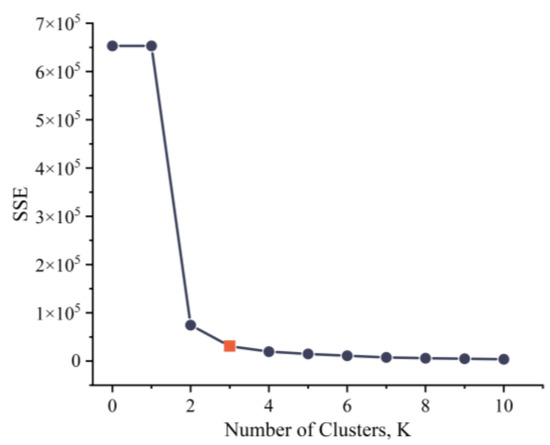
Figure 5.
The number of clusters, using the SSE index.

Table 3.
The result of the vehicle classification.
4. Data Analysis and Result
4.1. Speed Distribution
The speed of each vehicle type was summarized separately, and the distribution of the number of vehicles in different speed intervals was recorded, as shown in Figure 6. Furthermore, each vehicle type’s velocity frequencies were fitted using Gaussian curves to gain insight into the distribution mechanism of speed. The Gaussian fitting equation was denoted as follows:
where ,, and are model parameters, and represents the expected value of the speed. A Kolmogorov-Smirnov test confirmed the validity of the normal distribution, and the significance was 0.081, 0.142, and 0.193 (>0.05) for each vehicle type. The results of the fitting coefficients are shown in Table 4. From Table 4 and Figure 6, we found the following:
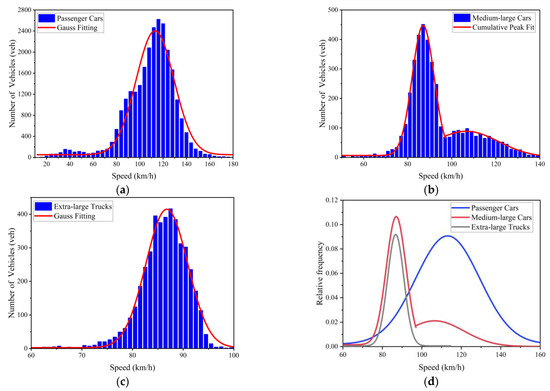
Figure 6.
(a) Speed distribution of passenger cars; (b) Speed distribution of medium-large cars; (c) Speed distribution of extra-large trucks; (d) Relative frequency of speed for all types of vehicles.

Table 4.
Basic information on speed and the coefficients of curve fitting.
(1) The speeds of all the vehicles satisfied the Gaussian distribution when the speed intervals of the three different types of vehicles were separated into steps of 4, 2, and 1 km/h. Among them, the goodness-of-fit for passenger cars was 0.961, and the expected speed was 113.1 km/h. The speed distribution of medium-large cars resulted from the accumulation of two Gaussian distribution curves, so there were two peaks, which were reached at = 87.0 km/h and = 106.5 km/h, with a goodness-of-fit of 0.987. The extra-large trucks had the best fit, with a goodness-of-fit of 0.992, peaking at = 86.6 km/h and then declining as speed rose.
(2) The one-way analysis of variance (ANOVA) showed that the speeds of the three vehicle types were significantly different at a significance level of 0.05 (F = 3273.64, p < 0.01). The speed of passenger cars was the most prominent (mean=108.6 km/h), followed by medium-large cars (mean = 92.4 km/h) and the most minor for extra-large trucks (mean = 85.1 km/h). The different vehicles’ speed minima did not differ significantly; however, the speed maxima of the two adjacent vehicle types differed by as much as 45 km/h. It demonstrated that the lower-speed threshold of the three vehicle types was generally the same (perhaps due to road construction or traffic congestion). In contrast, the upper-speed threshold had a major difference.
(3) With an overall speed distribution of 80~150 km/h, passenger cars had the biggest speed dispersion (SD = 22.1 km/h). Extra-large vehicles had the weakest speed dispersion (SD = 8.9 km/h), and their speed distribution was more tightly focused, mostly between 80 and 95 km/h. The speed dispersion of medium-large cars was intermediate between the other two (SD = 17.7 km/h), concentrated within 80~125 km/h. Therefore, only the speed data in the concentration region was considered in the subsequent analysis.
4.2. Trajectory Oscillation of Different Vehicle Types
Most freeway traffic accidents are closely related to the morphology and disturbance of the traveling trajectory. For studying the motion characteristics of the trajectory on straight sections of freeways, the LA and DTOC of various vehicle types were divided into intervals of 5 cm and 10 m, respectively. Figure 7, Figure 8 and Figure 9 show the relative frequency distribution and cumulative percentile curves of the LA and DTOC for different vehicle types. The results showed that the LA and DTOC of all vehicles obey the distribution of LogNormal. The functional expression for the LogNormal is as follows:
where represents the expected value of the corresponding indicator. The parameters of the log-normal distribution were obtained by maximum likelihood estimation, and the calculated results and indicator eigenvalues were statistically summarized in Table 5.
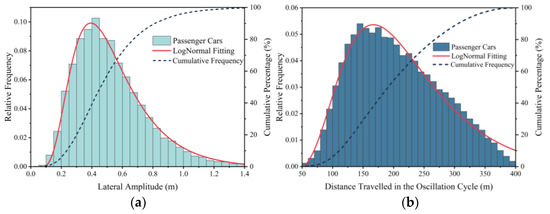
Figure 7.
(a) Distribution of the LA for passenger cars; (b) Distribution of the DTOC for passenger cars.
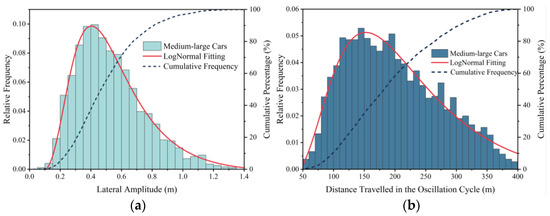
Figure 8.
(a) Distribution of the LA for medium-large cars; (b) Distribution of the DTOC for medium-large cars.
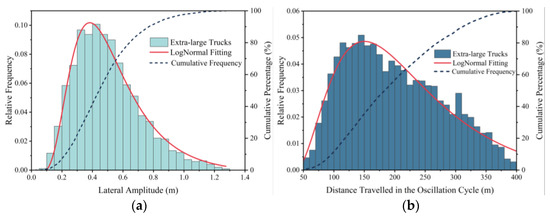
Figure 9.
(a) Distribution of the LA for extra-large trucks; (b) Distribution of the DTOC for extra-large trucks.

Table 5.
The coefficients of LogNormal and eigenvalues of the trajectory oscillation index.
The results showed subtle differences in the overall trajectory oscillation characteristics of the various vehicle types. The LA for extra-large trucks was significantly lower than that for passenger cars and medium-large cars. In contrast, the DTOC for passenger cars was considerably higher than for the other two vehicle types. It implies that the extra-large trucks’ longer and broader bodies tend to minimize the driver’s psychological margin, improving the driver’s awareness of keeping lanes. However, passenger cars usually travel faster and have more lateral space, thus causing the LA and DTOC to appear to be “double high”.
The cumulative frequency curves of the LA for all vehicles were S-shaped, with inflection points at the 15th and 85th, indicating that most drivers have a relatively concentrated distribution of lateral lane-keeping ability control range of 0.3~0.75 m. Unlike the LA, the cumulative frequency curves of the DTOC were similar to a linear ascending process, showing that drivers are not sensitive to the frequency of trajectory oscillation, and that the distribution is more discrete. Moreover, the fitted parameters of the log-normal model showed that the driver’s expectation of the LA kept around 0.5 m, and the expectation of the DTOC stayed at about 200 m. The expected value is closer to the mean value so that the mean can be subsequently utilized as one of the typical indicators.
4.3. Trajectory Oscillation of Different Lane Positions
Based on the test road segments, the lanes were divided into three categories: the inside lane (near the left kerb and central median), the outside lane (near the hard shoulder), and the middle lane (between the inside and outside lanes). The inside lanes included Lane 1 of the four-lane and six-lane divided highways. Lane 2 of the four-lane divided highway and Lane 3 of the six-lane divided highway were classified as outside lanes. The middle lane covered only Lane 2 of the six-lane divided highway (see Figure 2).
After the detailed division of the lanes, the trajectory oscillation patterns of the three vehicles in different lane positions were analyzed separately. Details about the trajectory oscillation are shown in Figure 10. The results in Figure 10 are as follows.
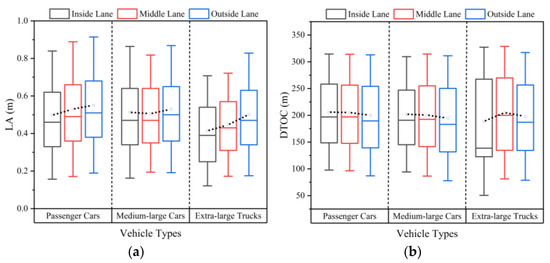
Figure 10.
(a) Distribution of the LA in different lane positions; (b) Distribution of the DTOC in different lane positions.
(1) The LA (F = 96.17, p < 0.01) and DTOC (F = 9.81, p < 0.01) showed significant differences for passenger cars in all three lane categories. Passenger cars had the smallest LA in the inside lane (mean = 0.498 m) and the giant LA in the outside lane (mean = 0.552 m). The DTOC gradually decreased in the three lanes, with a minimum of 139.29 m and a maximum of 258.32 m. Thus, it reveals that the trajectory oscillation of passenger cars is the most intense when driving in the outside lane. The larger oscillation amplitude and shorter oscillation period are more likely to lead to lane departure.
(2) The LA (F = 4.99, p = 0.0068 < 0.01) and DTOC (F = 3.43, p = 0.033 < 0.05) were also significantly different for medium-large cars at different lane locations. Contrary to passenger cars, medium-large cars had the least amount of LA in the middle lane and oscillated more in other lanes. All three lanes experienced a gradual decline in DTOC performance, but the decline was more significant between the middle and outside lanes and less pronounced between the inside and middle lanes. Consequently, driving in the middle lane is the safest option for medium-large cars.
(3) Among the three lanes, the LA for extra-large trucks (F = 18.26, p < 0.01) was significantly different, with performance comparable to that of passenger cars but with a modest increase over them. However, the DTOC for extra-large trucks (p = 0.12 > 0.05) was not significantly different across lanes. It might be because these vehicles are usually oversized and most of them are located in the right lane of traffic.
(4) Passenger cars have narrower widths and more lateral clearance when lane departing. Therefore, compared to the other two vehicle classes, the LA of passenger cars in the same lane is generally higher. In addition, benefiting from improved mobility, passenger cars move quicker and have more longitudinal displacement during trajectory oscillation. It will result in a broader field of influence during the oscillation and more reliance on road alignment.
4.4. Trajectory Oscillation of Different Speeds
The speed concentration interval of each vehicle was used as the research range to analyze the variation regulation of vehicle trajectory oscillation. The speed study ranges were 80~150 km/h and 80~125 km/h for passenger cars and medium-large cars, with 15 and 10 measurement points divided at fixed intervals of 5 km/h. The speed distribution of extra-large trucks was more concentrated, so seven measurement points were split at a smaller fixed interval of 2.5 km/h. Figure 11 shows the LA and DTOC for each type of vehicle at each speed measurement point. The percentile of 15th, 25th, 50th, 75th, 85th, and mean values were extracted, and the corresponding trend lines can be obtained by connecting the same eigenvalues.
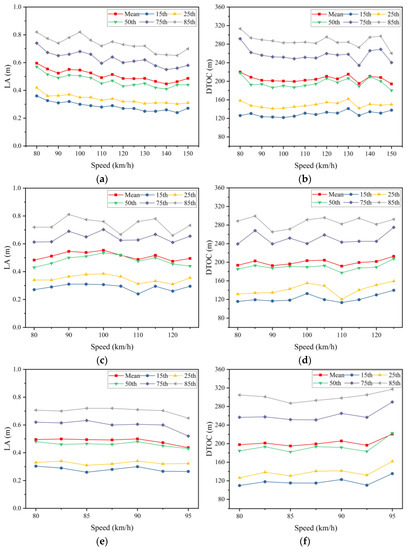
Figure 11.
The trend of trajectory oscillation indicators at different speed points. (a) The LA for passenger cars; (b) The DTOC for passenger cars; (c) The LA for medium-large cars; (d) The DTOC for medium-large cars; (e) The LA for extra-large trucks; (f) The DTOC for extra-large trucks.
The ANOVA results showed the LA (F = 6.14, p < 0.01) and DTOC (F = 2.14, p = 0.008 < 0.01) had significant differences for passenger cars at different speed points. So, speed is also an essential factor affecting the trajectory oscillation of passenger cars. Figure 11a,c,e show that the trend of LA with speed for all vehicles is not a simple linear relationship. In the interval of 80~90 km/h, the LA of passenger cars tended to decrease with increasing speed and reached a local minimum of 90 km/h. In this interval, the LA of medium-large cars rose with growing speed and caught a local maximum of 90 km/h. In the interval of 90~110 km/h, both showed a parabolic trend of increasing and then decreasing. In the subsequent process, the LA of passenger cars appeared to decline, while medium-large cars slowly increased. The tendency of LA with the speed of extra-large trucks was relatively smooth, and there was no sudden change.
Figure 11b,d,f show the variation curves of DTOC for each vehicle type. It can be seen that: in the interval of 80~90 km/h, the DTOC of passenger cars decreased gradually, while medium-large cars showed an increase and then dropped, and extra-large trucks were smoothly changing. The only valley of the passenger cars occurred when the speed reached 135 km/h, at which point the DTOC was the global minimum. The DTOC of medium-large cars showed a valley at a rate of 110 km/h, followed by a gradual increase. The trough occurred at 92.5 km/h for extra-large trucks, and the DTOC increased rapidly when the speed exceeded it. In addition, because the medium-large cars’ categories were more complex than the other two vehicle types and had the broadest coverage of dimensions, they exhibited a more volatile and less regular characteristic of trajectory oscillation.
In conclusion, the trend of trajectory oscillation of passenger cars and medium-large cars has a more complicated pattern of variation with increasing speed. Meanwhile, the movement of extra-large trucks is more homogeneous. The LA of passenger cars is the largest, and that of extra-large trucks is the lowest under the same speed conditions. As a result, passenger cars are operating at a higher risk. A reasonable trajectory oscillation prediction scheme must be developed to ensure that all vehicles can perform at a superior safety level at high speeds.
5. Discussion
The trajectory oscillation behavior of the vehicle is influenced by the combination of road alignment, vehicle performance, and driving ability. It serves as the main framework for researching driver lane-keeping behavior and practical lane-width design. For this objective, the variability between vehicle trajectory oscillation behaviors was discussed regarding vehicle type, lane position, and speed. These results suggest that the vehicle type is an integral factor in the variation of lateral offset [32]. Similarly, lane position and speed have varying degrees of influence on the lateral oscillation on straight sections of freeways [28]. It has been shown that the lane width is composed of lateral oscillation, vehicle width, and outside clearance [33]. However, Cheng’s study only used 70 questionnaires to determine the lateral offset at different speeds, which may lack powerful data support. Although previous research has also proposed suggested values for lane width [34,35], their subjects and scenarios were inconsistent with this study.
It is vital to determine how much each element influences the dependent variable because lane location and speed both considerably impact the magnitude of vehicle trajectory excursions. The analysis of covariance (ANCOVA) was used to explain the importance of this effect. Take passenger cars as an example; the average lateral amplitude at different speeds was divided into three groups based on the lane position; then, the lane position was used as the fixed factor, and speed was used as the covariate. The results of ANCOVA were obtained after the parallelism test (F = 0.019, p = 0.981 > 0.05) and the homogeneity of variance test (F = 1.986, p = 0.153 > 0.05). At the 0.05 level of significance, the F-value of the lane position was 2.850, with a concomitant probability of 0.073 (>0.05); the F-value of the speed was 19.732, with a concomitant probability of 0.000 (<0.05). Therefore, the speed greatly impacted how the lateral amplitude changed. Furthermore, the influence of lane position on the lateral amplitude was not significant once speed was taken into account. As a result, it may be concluded that speed, rather than lane position, primarily determines the vehicle trajectory’s lateral amplitude. The variations in speeds may be the cause of the trajectory oscillations of cars in various lane positions. The difference in trajectory oscillation at different lane positions may be due to the variation in speed. The observation revealed a stepwise declining relationship between the driving speeds of vehicles in the inside, middle, and outside lanes, demonstrating that high-speed automobiles prefer to travel inside the roadway [19].
The evaluation of road alignment consistency based on operating speed is critical to improving highway safety design and road service quality [23]. The lateral amplitude versus speed model was constructed, as speed was the primary factor affecting the trajectory oscillation. To accommodate the driving behaviors of the majority of drivers, the upper and lower limits were taken as the 85th percentile and the mean value of the lateral amplitude, respectively. Then, nonlinear regression analyses were adopted to quantify the relationship between speed and lateral amplitude. After comparing various nonlinear models, the mean and 85th percentile values of the lateral amplitude for passenger cars were regressed using the 4th-order polynomial and single exponential decay models. The adjusted goodness-of-fit of the models is 0.827 and 0.755, as shown in Equations (8)–(9). The average lateral amplitude of medium-large cars conforms to the periodic variation rule of the sine function. After excluding the outlier points, its 85th percentile value likewise complies with the sinusoidal distribution. The goodness-of-fit of the two models for medium-large cars is 0.609 and 0.582, as shown in Equations (10)–(11). For extra-large trucks, there is a massive correlation between the eigenvalues of the lateral amplitude and the polynomial function, and the regression efficiency of the third-order polynomial is optimal. The goodness-of-fit for extra-large trucks is 0.927 and 0.900, and the model expressions are shown in Equations (12)–(13).
where and are the mean and 85th percentile values of the lateral amplitude of passenger cars, is the speed of passenger cars. Similarly, stands for medium-large cars and stands for extra-large trucks. The relationship between the bounds of LA and speed for all vehicles is shown in Figure 12. Meanwhile, it reflects the regression model’s parameters and the fitting efficiency.
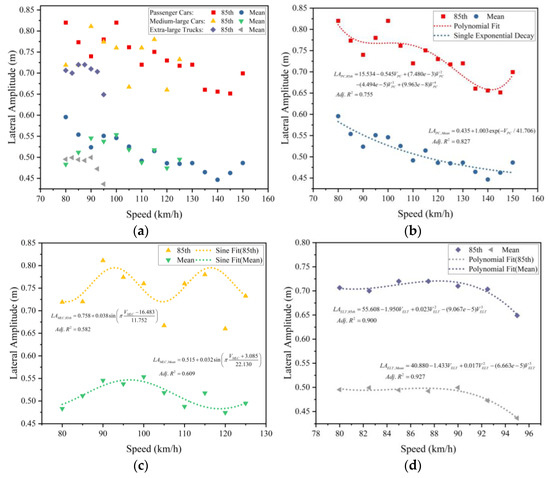
Figure 12.
The relationship between lateral amplitude and speed. (a) All types of vehicles; (b) Passenger Cars; (c) Medium-large cars; (d) Extra-large Trucks.
After establishing the prediction model of lateral amplitude, the validity of the models needs to be verified. Mean relative error (MRE), and root mean square error (RMSE) were picked as model assessment indexes. The calculation formulas are as follows:
where represents the number of sample points, stands for the predicted value of the th sample point, and is the actual value. The specific calculation results are shown in Table 6. From Table 6, the prediction performance of all models was accurate, with the MRE staying within 3% and the RMSE controlled within 0.03 m. Naturally, the models have certain conditions of applicability. For passenger cars, the models apply to calculate the lateral amplitude at vehicle speeds between 80 and 150 km/h; the applicable speed range for medium-large cars is 80 to 125 km/h; the suitable content for extra-large trucks is 80~95 km/h.

Table 6.
Verification of the lateral amplitude prediction model.
Following the prediction of the lateral amplitude, the vehicle width and the left and right clearance can be added to calculate the theoretical value of the lane width. The specific calculation expression is shown in Equation (16).
where is the lane width, is the left clearance, and is the right clearance. Experience dictates that each clearance is taken as 0.3 m. is the vehicle width, which is 1.9 m for passenger cars, 2.4 m for medium-large cars, and 2.5 m for extra-large trucks. Then, the lane width’s theoretical minimum and optimal value can be derived from the mean and 85th percentile values of lateral amplitude, as shown in Table 7.

Table 7.
Theoretical minimum and optimum values of lane width for different speeds.
According to the theoretical results, the lane width of the existing freeway still has plenty of room for most vehicles, which confirms the previous studies [10,11]. Therefore, in order to increase traffic throughput, it is feasible to allocate narrower freeway lanes to specific vehicles such as passenger cars [36,37]. A new finding is that the lateral amplitude of the vehicle does not follow a linear trend as speed increases, and it has a tendency to stabilize or even decrease in the high-speed situation. Several existing studies have concluded that lane widening effectively reduces crash frequency because it provides more space [38]. However, some studies suggest that lane widening does not have a significant positive impact on improving traffic safety but also increases the lateral offset of vehicles [39]. Obviously, the findings of this study are more in favor of the latter. Wider lanes not only use up valuable road space but also increase driving risk [16,40]. Consequently, the lateral oscillation characteristics of vehicle trajectories play a critical role in the design of the lane width. Safety and efficiency must be balanced while designing lanes.
6. Conclusions
This study sought to analyze the lateral oscillation characteristics of vehicle trajectories during the lane-keeping period on the straight sections of freeways. Two evaluation indicators of vehicle lateral motion were suggested, including the lateral amplitude (LA) and the distance traveled within the oscillation cycle (DTOC). These indicators help to provide a better explanation of trajectory oscillation and how other factors influence oscillatory behavior. To consider the lane-keeping behavior and the need for traffic safety, a new framework to determine the proper lane width by incorporating LA, lateral clearance, and vehicle width was proposed.
Firstly, data reduction principles and processes were established to remove irrelevant data from the analysis. Secondly, a cluster analysis was performed to reclassify the vehicles into three groups: passenger cars, medium-large cars, and extra-large trucks. Thirdly, the speed distributions of several vehicle kinds were examined. Then, the effects of vehicle types, lane positions, and speed were analyzed independently with regard to the LA and the DTOC. Finally, the theoretical values of the lane widths under different conditions were ascertained according to the trajectory oscillation characteristics. This study was based on the dataset of naturalistic vehicle trajectories on German highways (highD), and the following conclusions could be drawn.
(1) Different types of vehicles have different speed distributions on straight sections of freeways. Passenger cars have the most discrete and highest speed distribution, followed by medium-large cars and extra-large trucks. The operating speed of all vehicles obeys a Gaussian distribution.
(2) The lateral amplitude (LA) and distances traveled within the oscillation cycle (DTOC) of all vehicles followed a LogNormal distribution. The LA of extra-large trucks is the smallest among the three vehicle categories, while the DTOC of passenger cars is the largest. It shows that drivers of extra-large trucks are more capable of lane-keeping. Meanwhile, passenger cars are more prone to lane deviation due to their better performance and smaller size.
(3) There are significant differences in the LA of the three vehicle types at different lane positions: the smallest values for the inside lane and the highest for the outside lane. The trend of DTOC is diametrically the opposite, and it can be used as a guide to determine the minimum length of straight sections of the freeway. The changing patterns of trajectory oscillation of passenger cars and medium-large cars are more complex, while those of extra-large trucks are relatively simple at different speeds.
(4) In comparison to lane position, speed is the primary factor influencing trajectory oscillation. Differences in speed can also be used to explain the variations in vehicle trajectory behavior caused by lane positions. Via nonlinear regression, the fourth-order polynomial and single exponential decay models are consistent with the trends in the LA of passenger cars. However, medium-large cars and extra-large trucks are compatible with the sinusoidal function and third-order polynomial.
(5) Based on the mean and 85th percentile values of lateral amplitude, this study proposed a suggested width of exclusive lanes for different vehicles, including the minimum and optimum values. These results can provide a reference for the cross-sectional design of freeways, especially for exclusive lanes that are only available to certain types of vehicles (e.g., expressways for small passenger vehicles).
This study also has some limitations. Firstly, due to the restriction of the highD dataset, this study only analyzed the lateral oscillation characteristics under good weather conditions. However, bad weather will affect the lateral offset of the vehicle, resulting in higher lane wandering. Secondly, this study only looked at the situation of lane-keeping (see Figure 3), while the trajectory oscillation characteristics of lane changing and overtaking need to be further investigated. The influence of individual differences on trajectory oscillation can also be explored more profoundly in the future.
Author Contributions
Conceptualization, J.X.; methodology, R.D.; software, C.P.; validation, J.X., R.D. and C.P.; formal analysis, R.D.; investigation, R.D. and Z.D.; resources Z.D.; data curation, R.D., C.P. and Z.D.; writing—original draft preparation, R.D.; writing—review and editing, R.D.; visualization, R.D.; supervision, J.X.; project administration, J.X.; funding acquisition, J.X. All authors have read and agreed to the published version of the manuscript.
Funding
This work was funded by the National Key R&D Program of China (Grant No. 2018YFB1600500), and the Program for Creative Research Groups at Institutions of Higher Education in Chongqing (Grant No. CXQT21022).
Institutional Review Board Statement
Ethical review and approval were waived for this study, due to this study not involving human physiological and psychological data, which was not within the scope of review by the Chongqing Jiaotong University Ethical Review Committee.
Informed Consent Statement
Informed consent was obtained from all subjects involved in the study.
Data Availability Statement
The raw dataset (the highD) is available online at: http://www.highD-dataset.com (accessed on 15 July 2022). The supplementary data in this article are available on request from the corresponding author.
Conflicts of Interest
The authors declare no conflict of interest.
References
- Bianchi, D.; Ferrara, A.; Di Benedetto, M.D. Networked model predictive traffic control with time varying optimization horizon: The Grenoble South Ring case study. In Proceedings of the 2013 European Control Conference (ECC), Zurich, Switzerland, 17–19 July 2013; pp. 4039–4044. [Google Scholar] [CrossRef]
- Labi, S.; Chen, S.; Preckel, P.V.; Qiao, Y.; Woldemariam, W. Rural two-lane highway shoulder and lane width policy evaluation using multiobjective optimization. Transp. A Transp. Sci. 2017, 13, 631–656. [Google Scholar] [CrossRef]
- Dai, B.; Hudson, J.G.; Ettelman, B.; Park, E.S. Influence of lane width on bus crashes. Transp. Res. Rec. 2021, 2675, 87–97. [Google Scholar] [CrossRef]
- American Association of State Highway and Transportation Officials (AASHTO). A Policy on Geometric Design of Highways and Streets, 6th ed.; American Association of State Highway and Transportation Officials: Washington, DC, USA, 2011. [Google Scholar]
- JTG B01-2014; Technical Standard of Highway Engineering. Ministry of Transportation of China Press: Beijing, China, 2014.
- Road and Transportation Research Association (RTRA). Guidelines for the Design of Motorways; Road and Transportation Research Association: Germany, Cologne, 2008. [Google Scholar]
- Transportation Association of Canada (TAC). Geometric Design Guide for Canadian Roads; Transportation Association of Canada: Ottawa, ON, Canada, 1999. [Google Scholar]
- The UK Highways Agency (HA). Design Manual for Roads and Bridges; The UK Highways Agency: London, UK, 2020. [Google Scholar]
- Transportation Research Board (TRB). Highway Capacity Manual; Transportation Research Board: Washington, DC, USA, 2010. [Google Scholar]
- Kondyli, A.; Hale, D.K.; Asgharzadeh, M.; Schroeder, B.; Jia, A.; Bared, J. Evaluating the operational effect of narrow lanes and shoulders for the highway capacity manual. Transp. Res. Rec. 2019, 2673, 558–570. [Google Scholar] [CrossRef]
- Dixon, K.; Fitzpatrick, K.; Avelar, R. Operational and safety trade-offs reducing freeway lane and shoulder width to permit an additional lane. Transp. Res. Rec. 2016, 2588, 89–97. [Google Scholar] [CrossRef]
- Fitzpatrick, K.; Dixon, K.; Avelar, R. Evaluating operational implications of reduced lane and shoulder widths on freeways. J. Transp. Eng. 2016, 142, 04016052. [Google Scholar] [CrossRef]
- Zheng, J.; Sun, J.; Yang, J. Relationship of lane width to capacity for urban expressways. Transp. Res. Rec. 2015, 2483, 10–19. [Google Scholar] [CrossRef]
- Wang, Q.; Yan, Y.; Wang, K. Research on optimized design of road space in mixed sections of historical district: A case study of Xi’an China. Can. J. Civ. Eng. 2021, 48, 1105–1114. [Google Scholar] [CrossRef]
- Chang, X.; Li, H.; Rong, J.; Chen, X.; Wang, Y. Determining the appropriate lane width at urban signalised intersections—A case study in Beijing. IET Intell. Transp. Syst. 2019, 13, 1785–1791. [Google Scholar] [CrossRef]
- Wu, L.; Sun, J.; Li, T. Relationship between lane width and safety along urban expressways in Shanghai. J. Transp. Eng. Part A Systems 2019, 145, 05018004. [Google Scholar] [CrossRef]
- Liu, S.; Wang, J.; Fu, T. Effects of lane width, lane position and edge shoulder width on driving behavior in underground urban expressways: A driving simulator study. Int. J. Environ. Res. Public Health 2016, 13, 1010. [Google Scholar] [CrossRef]
- Mecheri, S.; Rosey, F.; Lobjois, R. The effects of lane width, shoulder width, and road cross-sectional reallocation on drivers’ behavioral adaptations. Accid. Anal. Prev. 2017, 104, 65–73. [Google Scholar] [CrossRef]
- Shirke, C.; Sumanth, N.; Arkatkar, S.; Bhaskar, A.; Joshi, G. Modeling expressway lane utilization and lane choice behaviour: A case study on Delhi–Gurgaon Expressway. Transp. Lett. 2017, 11, 250–263. [Google Scholar] [CrossRef]
- Yousif, S.; Al-Obaedi, J.; Henson, R. Drivers’ lane utilization for United Kingdom motorways. J. Transp. Eng. 2013, 139, 441–447. [Google Scholar] [CrossRef]
- Aydin, M.M. A new evaluation method to quantify drivers’ lane keeping behaviors on urban roads. Transp. Lett. 2020, 12, 738–749. [Google Scholar] [CrossRef]
- Jung, C.R.; Kelber, C.R. A lane departure warning system using lateral offset with uncelebrated camera. In Proceedings of the 2005 8th IEEE International Conference on Intelligent Transportation Systems (ITSC), Vienna, Austria, 13–16 September 2005; pp. 348–353. [Google Scholar]
- Yu, Z.; Chen, Y.; Zhang, X.; Xu, J. Track behavior and crash risk analysis of passenger cars on hairpin curves of two-lane mountain roads. J. Adv. Transp. 2021, 2021, 4906360. [Google Scholar] [CrossRef]
- Chen, Y.; Quddus, M.; Wang, X. Impact of combined alignments on lane departure: A simulator study for mountainous freeways. Transp. Res. Part C Emerg. Technol. 2018, 86, 346–359. [Google Scholar] [CrossRef]
- Ghasemzadeh, A.; Ahmed, M.M. Drivers’ lane-keeping ability in heavy rain preliminary investigation using SHRP 2 naturalistic driving study data. Transp. Res. Rec. 2017, 2663, 99–108. [Google Scholar] [CrossRef]
- Ghasemzadeh, A.; Ahmed, M.M. Utilizing naturalistic driving data for in-depth analysis of driver lane-keeping behavior in rain: Non-parametric MARS and parametric logistic regression modeling approaches. Transp. Res. Part C Emerg. Technol. 2018, 90, 379–392. [Google Scholar] [CrossRef]
- Hu, H.; Gao, Z.; Yu, Z.; Sun, Y. An experimental driving simulator study of unintentional lane departure. Adv. Mech. Eng. 2017, 9, 1–8. [Google Scholar] [CrossRef]
- Raju, N.; Kumar, P.; Jain, A.; Arkatkar, S.S.; Joshi, G. Application of trajectory data for investigating vehicle behavior in mixed traffic environment. Transp. Res. Rec. 2018, 2672, 122–133. [Google Scholar] [CrossRef]
- Kanagaraj, V.; Asaithambi, G.; Toledo, T.; Lee, T.C. Trajectory data and flow characteristics of mixed traffic. Transp. Res. Rec. 2015, 2491, 1–11. [Google Scholar] [CrossRef]
- Krajewski, R.; Bock, J.; Kloeker, L.; Eckstein, L. The highD dataset: A drone dataset of naturalistic vehicle trajectories on German highways for validation of highly automated driving systems. In Proceedings of the 2018 21st IEEE International Conference on Intelligent Transportation Systems (ITSC), Maui, HI, USA, 4–7November 2018; pp. 2118–2125. [Google Scholar]
- Zheng, Z.; Xiang, Q.; Gu, X.; Ma, Y.; Zheng, K. The influence of individual differences on diverging behavior at the weaving sections of an urban expressway. Int. J. Environ. Res. Public Health 2021, 18, 25. [Google Scholar] [CrossRef] [PubMed]
- Lin, D.; Chen, X.; Lin, B.; Li, L. Phenomena and Characteristics of Moped-Passing-Bicycle on Shared Lanes. In Proceedings of the 93th Transportation Research Board (TRB) Annual Meeting, Washington, DC, USA, 12–16 January 2014. [Google Scholar]
- Cheng, G.; Zhang, S.; Wu, L.; Qin, L. Spacing and geometric design indexes of auxiliary lanes on two-lane highway in China. Adv. Mech. Eng. 2017, 9, 1–9. [Google Scholar] [CrossRef]
- Kvasnes, S.; Pokorny, P.; Jensen, J.K.; Pitera, K. Safety effects of horizontal curve design and lane and shoulder width on single motorcycle accidents in Norway. J. Adv. Transp. 2021, 2021, 6684334. [Google Scholar] [CrossRef]
- Yan, X.; Wang, T.; Ye, X.; Chen, J.; Yang, Z.; Bai, H. Recommended widths for separated bicycle lanes considering abreast riding and overtaking. Sustainability 2018, 10, 3127. [Google Scholar] [CrossRef]
- Ghiasi, A.; Hussain, O.; Qian, Z.; Li, X. Lane management with variable lane width and model calibration for connected automated vehicles. J. Transp. Eng. Part A Systems 2020, 146, 04019075. [Google Scholar] [CrossRef]
- Ogle, J.H.; Ladue, M.N.; Sarasua, W.A.; Davis, W.J.; Mammadrahimli, A.; Zhao, X. Operational performance of two-way left-turn lanes driving simulator evaluation. Transp. Res. Rec. 2015, 2518, 122–129. [Google Scholar] [CrossRef]
- Park, J.; Abdel-Aty, M. Safety performance of combinations of traffic and roadway cross-sectional design elements at straight and curved segments. J. Transp. Eng. Part A Systems. 2017, 143, 04017015. [Google Scholar] [CrossRef]
- Rahman, M.A.; Sun, X.; Das, S. Reconfiguring urban undivided four-lane highways to five-lane: A nonideal but very effective solution for crash reduction. J. Transp. Eng. Part A Systems 2020, 146, 04020116. [Google Scholar] [CrossRef]
- Milton, J.; Mannering, F. The relationship among highway geometrics, traffic-related elements and motor-vehicle accident frequencies. Transportation 1998, 25, 395–413. [Google Scholar] [CrossRef]
Publisher’s Note: MDPI stays neutral with regard to jurisdictional claims in published maps and institutional affiliations. |
© 2022 by the authors. Licensee MDPI, Basel, Switzerland. This article is an open access article distributed under the terms and conditions of the Creative Commons Attribution (CC BY) license (https://creativecommons.org/licenses/by/4.0/).